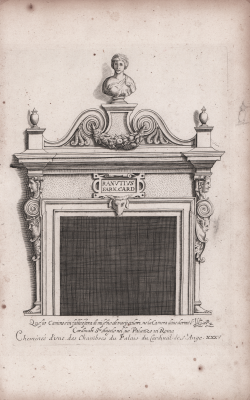



| Reference: | S1466 |
| Author | François Jollain |
| Year: | 1680 ca. |
| Printed: | Paris |
| Measures: | 205 x 295 mm |


| Reference: | S1466 |
| Author | François Jollain |
| Year: | 1680 ca. |
| Printed: | Paris |
| Measures: | 205 x 295 mm |
Plate taken from the famous Regola delli cinque ordini d'architettura by Jacopo Barozzi da Vignola, first printed in Rome in 1562. It is one of the most famous and successful books on architecture of the Renaissance, which went through an impressive number of editions until the end of the 18th century. The success of the Regola delli cinque ordini d'architettura is linked primarily to its didactic effectiveness. It is, in fact, a sort of handbook that presents a system of calculation aimed at facilitating the task of builders in designing and building their works according to the five architectural orders: Doric, Ionic, Corinthian, Tuscan and Composite or Roman. Barozzi elaborated, for each order, an algorithm that allowed to calculate the thickness of the column starting from a given height, obtaining the radius of the shaft of the column, unit of measurement on the basis of which he then proceeded to calculate the size of the other architectural elements (pedestal, capital, entablature), which all had to submit to a strict general rule of proportion.
Jacopo Barozzi, originally from Vignola, was not only a great architect, but also a painter, cartographer and hydraulic engineer.
Of the plates that make-up the work (including the frontispiece), plates III-XXXII illustrate the architectural orders, plates XXXIII-XXXVII are dedicated to portals by Barozzi (the portal of the Farnese palace of Caprarola, the door of S. Lorenzo in Damaso, the portal of the Palazzo della Cancelleria always for Card. Farnese) and the fireplace of the palace of Card. Sant'Angelo in Rome. Starting from 1602 were added the plates XXXVIII- XLIV, which propose the doors designed in Rome by Michelangelo (Porta Flaminia called del Popolo, Porta Pia, a portal of the Campidoglio, Porta della Vignea of the Patriarch Grimani and that of the Cardinal of Sermoneta).
Example from the edition of Paris, printed with the title Regles des cinq ordres d'architecture, by Francois Jollain, about 1680.
Copper engraving, printed on contemporary laid paper, with margins, in good condition.
|
Publisher, printseller of rue S. Jacques a la ville de Colloigne. took over his father's business c.1686. He specialized in engraving and publishing portraits, fashions and costumes. He published a collection of costumes of various nations, the plates were separately published and are very rare.
|
|
Publisher, printseller of rue S. Jacques a la ville de Colloigne. took over his father's business c.1686. He specialized in engraving and publishing portraits, fashions and costumes. He published a collection of costumes of various nations, the plates were separately published and are very rare.
|